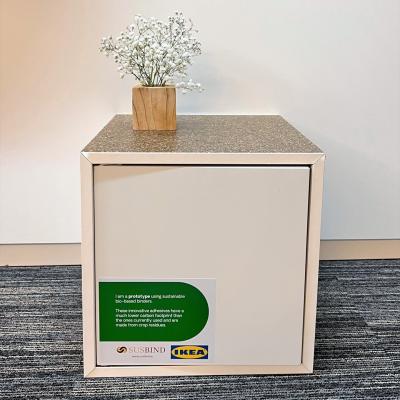Panel boards used in mass-produced furniture comprise small wood chips bound together by an adhesive – a so-called binder. Most binders are made of fossil materials. Hardly any bio-based binder has been scaled in a way that would make it part of regular large-scale production. Considering circular approaches, several initiatives are underway to produce alternative binders from renewable resources.
Bringing together partners from research institutes and companies from several European countries, the CBE JU-funded SUSBIND project developed an alternative to formaldehyde binder, a volatile organic compound typically found in furniture that can have adverse health effects.
'We successfully synthesised a bio-based binder for interior particle boards and medium-density fibre boards that outperforms existing non-renewable materials: it reduces formaldehyde emissions, thereby improving the air we breathe in our houses and offices,' notes Stephen Webb, CEO at Austria-based company RTDS Groupe that coordinated SUSBIND.
The chemical synthesis process
Project partners experimented with crops such as natural side streams, surplus carbohydrates, plant oils and fats to convert them into a bio-based chemical composition binder.
Advanced enzymatic technology was used to epoxidise complex fatty acid mixtures derived from vegetable oils. Carbohydrates proved to be the most effective green raw material for reactive intermediates. Different binder compositions were tested in laboratory experiments. The most promising ones comprised fructose, hydroxymethylfurfural (HMF), hexamethylenediamine (HMDA) and bis(hexamethylene)triamine (BHT) as amine crosslinkers.
Wood-based boards are almost entirely made from renewable resources.
RTDS Groupe CEO Stephen Webb
'The outcome is a sugar-based binder obtained from surplus and sustainable feedstock from European biorefineries. As 80 % of the sugar-based binder is derived from biomass, wood-based boards are almost entirely made from renewable resources,' notes Webb. The remaining 20 % is made from a synthetic crosslinker. The SUSBIND binder has a lower impact on human health and is formaldehyde-free.
Binder testing and sustainability analysis
The renewable binder was tested at the laboratory to determine viscosity, solid content and pH, bonding strength development, pressing times and temperatures. The newly produced boards (TRL 5) were validated at IKEA in Sweden.
SUSBIND particle boards in IKEA's prototype box proved to be comparable to those made of urea-formaldehyde in terms of internal bond strength and pressing times. Furthermore, the formaldehyde amount in these boards was found to be lower than the limit set by European standards (EN 312).
The potential human health impacts analysis showed that SUSBIND wood-based boards could emit higher amounts of acetic acids than their counterparts. However, results confirmed that the SUSBIND boards using the new binder did not cause an increase in harmful emissions, mainly owing to the absence of formaldehyde.
Life cycle analyses showed that the renewable binder did not reach the envisaged target of a 5 % reduction in carbon footprint compared to the formaldehyde binder. However, reducing the amount of the BHT crosslinker in the binder formulation or switching to an alternative could help reduce the carbon footprint.
A way into the future
The SUSBIND project set the collaboration framework and the technical solution for the future of bio-based binders for furniture. SUSBIND has also published an industry-led White Paper for the EU Ecolabel revision.
'SUSBIND can be summed up in three words: supply chain success,' notes Massimo Bregola, project scientific coordinator and global application lead at Cargill. 'We followed our dream to deliver something sustainable for future generations. With the cooperation of all partners and many stakeholders along the value chain, we have come a long way to make that dream a reality in the future.'

